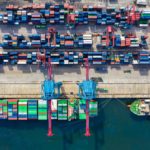Panama Canal Update: Down to 125 Ships Waiting as Congestion Improves
I posted a week ago about the massive delays happening at the Panama Canal. I’ve seen new articles on the topic, published today and yesterday, that would make you think the situation has only gotten worse over the last seven days. While the number of ships waiting has increased by some reported numbers I read today, the situation is actually improving. The number of ships waiting has reduced.
The number of ships waiting right now is not up to 160+, which I would have mistakenly shared with you if I hadn’t fact-checked the number. The number of ships waiting is not “some 200” as the top tweet about the Panama Canal (at the time of this writing) states:
We should all know to be dubious of any “facts” we read on social media posts at this point, though this tweet (or X) does share a pretty cool video of waiting ships.

The most current data I found in a news article on the congestion at the Panama Canal comes from Elida Moreno and Marianna Parraga, whose reporting is in a Reuters article:
As of Tuesday [today], 125 booked and non-booked vessels were waiting to pass, down from more than 160 ships two weeks ago, according to official numbers. Another 40 vessels were approaching the waterway, versus 50 two weeks ago, according to Refinitiv Eikon data.
The situation is improving, but it certainly isn’t over according to the Reuters article:
A backlog of vessels waiting to pass the Panama Canal due to drought-related restrictions has eased in recent days after the waterway’s authority authorized more non-booked ships to pass and as others are choosing alternate routes to avoid the delays.
The Panama Canal Authority last week opened two additional slots per day for vessels without booking to transit to help clear bottlenecks on both sides of the interoceanic corridor.
It has, however, kept the total number of ships passing through to per day to a maximum of 32, versus 36 per day in normal conditions.
I wouldn’t be surprised if this story gains more mainstream coverage in the upcoming weeks. The biggest reason is a drought is the root cause for the backup, and mainstream media outlets will therefore use it in their alarmist climate catastrophe narratives. In fact, they’ve already been doing that.
Additionally, the fact the Panama Canal is a significant connection point for international shipping supply chains may cause media outlets to talk about it, as the supply chain became something of a hot-button topic over the last few years. The Panama Canal is particularly important for U.S.-related international shipping. There will be delays in cargo heading to the U.S., potential for upward pressure on freight rates, and ultimately an impact for U.S. consumers as holiday shopping seasons approach. It’s one more thing politicians and media outlets can use as a scapegoat for poor economic performance.
However, the situation is improving at the moment. Of course, we’re still watching it carefully here at Universal Cargo to make sure to give you the best service possible when it comes to importing and exporting your goods. The situation could again take a negative turn. Even without that, its effects are rippling through the supply chain. With this peak season being on the weaker side, the Panama Canal’s congestion is not having as big of an impact as it could have had. We can call that a silver lining. Of course, Panama could use the rain clouds rather than their silver linings.





